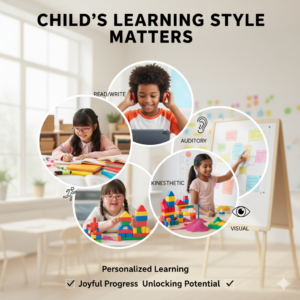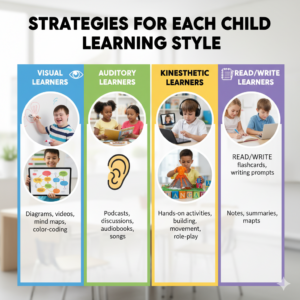Every parent wants to see their child succeed in school and beyond, but here’s the challenge: kids don’t all learn the same way. Some grasp concepts quickly when they hear them explained, others need to see them mapped out, and still others won’t fully understand until they’ve tried it with their own hands. That’s why understanding your child learning style is such a game-changer.
When you uncover the way your child prefers to process information, you unlock strategies that make homework less of a battle, strengthen study habits, and build real confidence. This isn’t about putting your child in a box—it’s about opening doors to more effective learning.
A child learning style describes the way your child naturally prefers to absorb, understand, and retain information. You’ll hear about terms like visual learners, auditory learners, kinesthetic learners, and reading/writing learners.
These categories come from educational theories such as VARK (Visual, Auditory, Reading/Writing, Kinesthetic) and Gardner’s theory of multiple intelligences. Even though researchers debate whether teaching strictly to a style improves test scores, most agree that recognizing these patterns helps parents and teachers adapt their methods in ways that feel more natural and supportive for children.
Put simply: when kids feel comfortable with how information is presented, they’re more motivated, less frustrated, and better able to remember what they’ve learned.

Let’s break down the most common types of child learning styles, along with how you might recognize them in your own child.
Visual learners absorb information best when they can see it. They love charts, diagrams, videos, and color-coded notes. If your child remembers faces better than names, doodles while thinking, or says, “Can you show me?”, chances are they lean visual.
Auditory learners thrive when they hear information. They benefit from discussions, songs, rhymes, and lectures. If your child loves being read to, remembers lyrics easily, or prefers explaining things out loud, they may be primarily auditory.
Kinesthetic learners process knowledge through movement and touch. They need hands-on activities, experiments, and role-play. If your child can’t sit still for long, enjoys sports, or learns by building and creating, they’re likely kinesthetic.
This group prefers information in words. They learn best through textbooks, essays, journaling, and written instructions. If your child likes making lists, writing summaries, or thrives on structured reading, they fit this category.
Recognizing your child learning style isn’t about giving them a test and calling it final. It’s about observation, flexibility, and a bit of experimentation.
Present the same material in different formats—explain it verbally, sketch it out, let them try it, and offer written notes. Notice which approach “clicks” fastest.
Even young children can share preferences. Ask questions like:
Teachers often notice patterns during class activities. Ask them what they observe when your child participates in group discussions, written assignments, or labs.
Once you have a sense of your child’s learning preferences, you can adjust your support at home.

Here’s the reality: most children are not just one type. They often use a mix of learning styles depending on the subject or situation.
For example, a child might be a strong auditory learner in language arts but prefer kinesthetic methods in science. That’s why it’s best to blend strategies—show visuals, discuss them out loud, and add a hands-on task. This well-rounded method supports adaptability and prepares children for different teaching methods they’ll encounter in school.
5 Powerful Tips for Parents
Here are five practical ways to apply learning styles in your home right away:
Q: Can my child have more than one learning style?
Yes. Most kids use multiple styles, though one or two may be stronger.
Q: At what age does a child’s learning style show?
You can see preferences as early as preschool, but they may evolve as your child matures.
Q: Will knowing my child’s style guarantee better grades?
Not directly. Research shows learning styles don’t automatically raise scores. But they make studying more engaging and effective, which often leads to better results.
Q: What if my child’s teacher doesn’t use their preferred style?
Support them at home. Reinforce lessons in a format that works best for your child.
Q: Should I reassess over time?
Yes. Check in every year or so—kids’ preferences often shift with age and subject.
Understanding your child learning style is about unlocking potential, not boxing them in. It helps you meet your child where they are, whether that’s through pictures, conversations, hands-on projects, or writing. More importantly, it gives your child the confidence to say, “This is how I learn best,” and the flexibility to adapt when situations demand something different.
Think of learning styles as tools in your parenting toolkit. Use them to build stronger study habits, reduce stress, and create an environment where learning feels natural, engaging, and—dare I say—fun.